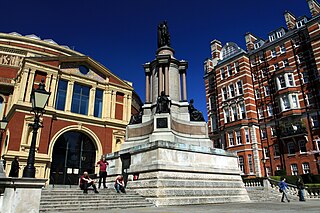 W
WThe Great Exhibition of the Works of Industry of All Nations or The Great Exhibition, an international exhibition, took place in Hyde Park, London, from 1 May to 15 October 1851. It was the first in a series of World's Fairs, exhibitions of culture and industry that became popular in the 19th century. The Great Exhibition was organised by Henry Cole and by Prince Albert, husband of the reigning monarch of the United Kingdom, Queen Victoria.
 W
WAlbertopolis is the nickname given to the area centred on Exhibition Road in London, named after Prince Albert, consort of Queen Victoria. It contains many educational and cultural sites. It is in South Kensington, split between the Royal Borough of Kensington and Chelsea and the City of Westminster, and the area bordered by Cromwell Road to the south and Kensington Road to the north.
 W
WThe Crystal Palace was a cast iron and plate glass structure, originally built in Hyde Park, London, to house the Great Exhibition of 1851. The exhibition took place from 1 May to 15 October 1851, and more than 14,000 exhibitors from around the world gathered in its 990,000 square feet (92,000 m2) exhibition space to display examples of technology developed in the Industrial Revolution. Designed by Joseph Paxton, the Great Exhibition building was 1,851 feet (564 m) long, with an interior height of 128 feet (39 m). It was three times the size of St Paul's Cathedral.
 W
WExhibition Road is a street in South Kensington, London which is home to several major museums and academic establishments, including the Victoria and Albert Museum, the Science Museum and the Natural History Museum.
 W
WHyde Park is a Grade I-listed major park in Central London. It is the largest of four Royal Parks that form a chain from the entrance of Kensington Palace through Kensington Gardens and Hyde Park, via Hyde Park Corner and Green Park past the main entrance to Buckingham Palace. The park is divided by the Serpentine and the Long Water lakes.
 W
WThe Memorial to the Great Exhibition is an outdoor monument commemorating the Great Exhibition (1851) and depicting Albert, Prince Consort, designed by Joseph Durham with modifications by Sydney Smirke and located south of Royal Albert Hall in London, United Kingdom. Originally installed in the Royal Horticultural Society gardens in 1863, it was relocated to its current site during 1891–1893 when the gardens were reconstructed and Prince Consort Road was created.
 W
WPrince Albert’s Model Cottage was the name given to a model dwelling designed in the mid-19th century to offer an alternative form of accommodation for poor families in England. It was supported by Prince Albert, husband of Queen Victoria.
 W
WThe Royal Commission for the Exhibition of 1851 is an institution founded in 1850 to administer the international exhibition of 1851, officially called the Great Exhibition of the Works of Industry of all Nations. The Great Exhibition was held in The Crystal Palace in Hyde Park London, England. The enormous building was designed by Joseph Paxton for the Exhibition and construction was supervised by William Cubitt using a cast iron space frame for the glass panes, with wooden beams for flooring.
 W
WThe Victoria and Albert Museum in London is the world's largest museum of applied and decorative arts and design, as well as sculpture, housing a permanent collection of over 2.27 million objects. It was founded in 1852 and named after Queen Victoria and Prince Albert.